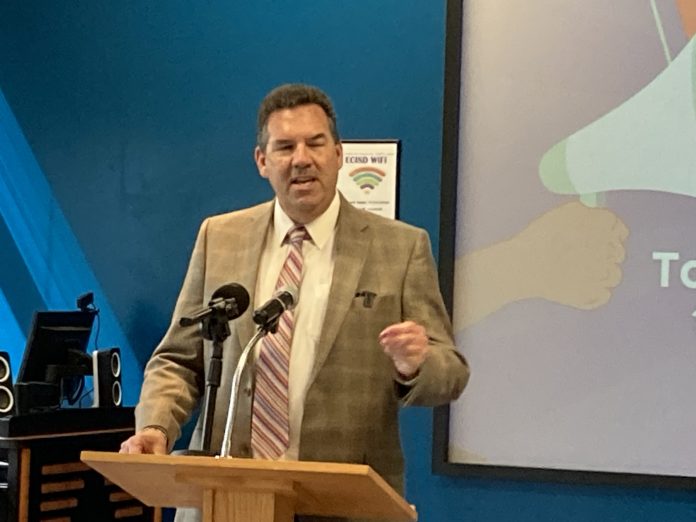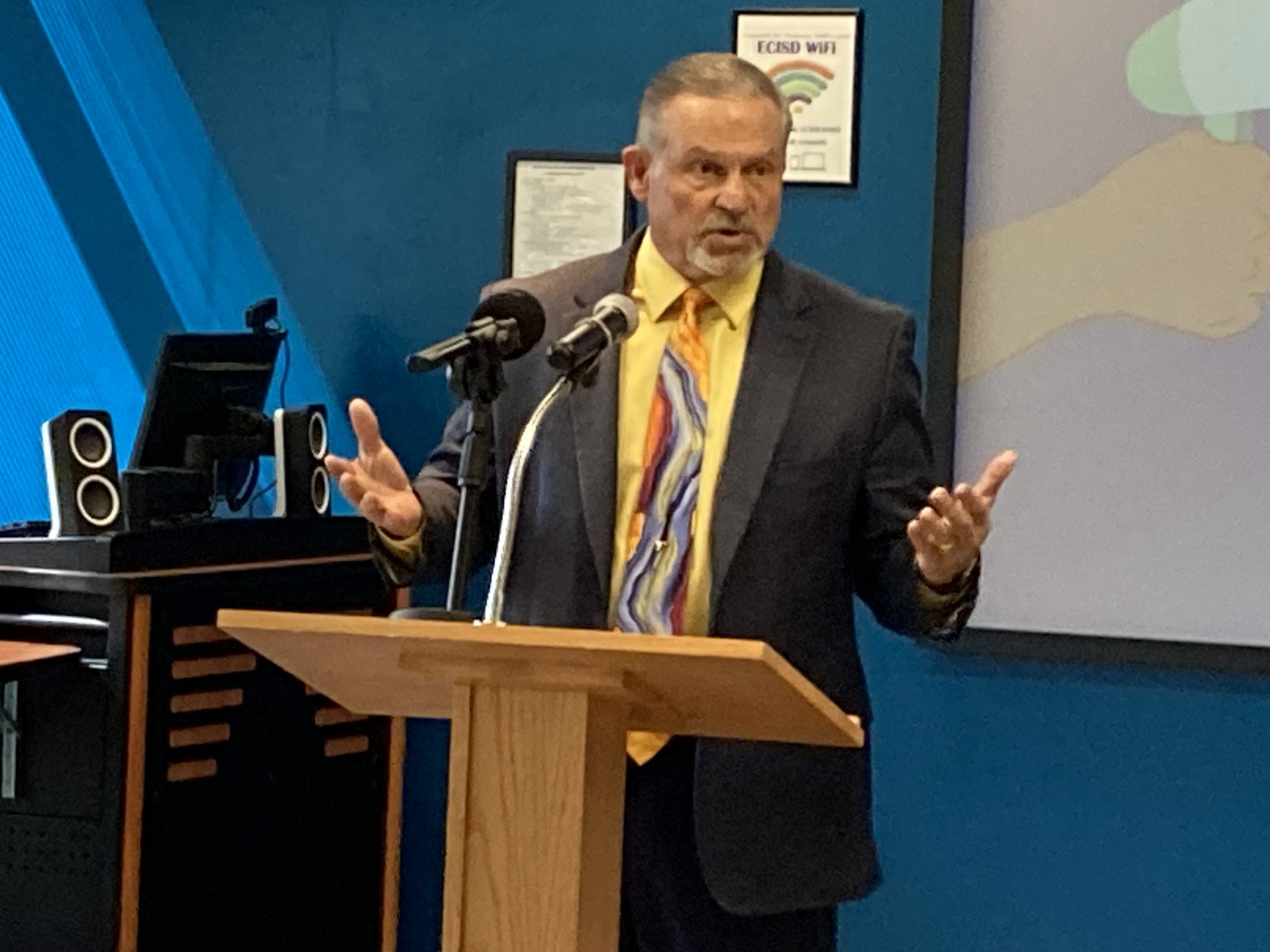
With the legislative session drawing to a close in about a month and school funding projected to decline, Ector County ISD Superintendent Scott Muri, ECISD Secondary Teacher of the Year Melisa Valenzuela and Big Spring ISD Superintendent Jay McWilliams held a news conference Monday to urge residents to call their representatives urging them to allocate more money for public education using some of the state’s $32 billion surplus.
The news conference was held in Conference Room A/B on the third floor of the administration building in Odessa with a backdrop of Mayday! Mayday! Mayday! — the call for help when an airplane is going down. Along with media, it was attended by ECISD Board President Steve Brown, member Delma Abalos and a handful of district officials.
Muri said districts statewide are in need of financial assistance and inflation has “consumed our budgets.”
“From 2019 to today we’ve experienced a 17% rate of inflation and our … daily expenses have risen. In fact, in ECISD specifically our fuel costs have increased by 7.5 percent from 2019 to today. The cost of utilities in our district has increased by 10% from 2019 to today. Our insurance prices have gone up by 40% from 2019 to today; the maintenance that we do in our facilities, those maintenance costs have increased by 37% from 2019 to today. And then the food that we provide for our students has increased by 8%,” Muri said.

He said the district is not able to do as much as in 2019. “Secondly, the message that we would like to deliver is that we must provide significant and meaningful raises to our employees,” Muri added.
Just as expenses to school systems statewide have jumped, so have expenses for families who work for the district.
“But we don’t come today with just problems. We come with a solution … The solution for ECISD and for districts across the state of Texas today is to leverage $32 billion in excess revenue that we’ve received as a state to invest in public education from one end of our state to the other,” Muri said.
He added that if a portion of the surplus isn’t used to increase education funding, the district will face some really difficult decisions and that will be seen statewide.
If there isn’t funding for raises, people will leave for other areas and it will be hard to attract people to Texas unless they remain competitive. Things like extracurricular activities and curriculum tools are funded with the budget.
Muri said that they would like to see a $1,000 increase in the basic allotment, the base amount districts receive per student from the state. For ECISD, it’s $6,100 per student and it hasn’t changed in several years. Muri and McWilliams said they would like to see a $1,000 increase.
Additional funding is added for students who are in special populations like special education, children of poverty and bilingual, for example.
Muri said they recognize that legislators are busy and they recognize lawmakers for the good work they’ve done. He praised Rep. Brooks Landgraf, R-Odessa, as “a wonderful example of the type of leadership that is making a profound effect on public education, and specifically the financial situation of our own school district.
“… We we challenge our other state legislators across the state of Texas to think differently about how we’re currently investing in public education. We appreciate the investments that have been made and the conversations that are happening, but we encourage there will be deeper and more meaningful conversations about the specific needs that we have in public education,” Muri said.
He said districts don’t want the state to spend all $32 billion on public education, but to invest more in public education.
“We appreciate the investments that they’re considering and appreciate the fact that they look beyond education to other opportunities for investment in the state of Texas. But there is a teacher shortage in our state, not only in our local districts here in West Texas, but across the state of Texas. We continue to deal with a teacher shortage and we must invest in public education in order for us to address the shortage that we have. That shortage is not going away anytime soon. If we do not make wise investments today, that shortage will continue for years to come …,” Muri said.
Abalos also urged lawmakers to give districts the funds they need to serve children. Economist Ray Perryman has said every $1 invested in public education yields $56.76.
“But what’s important is that everybody here and out there, call them (legislators) and let them know that we believe in public education,” Abalos said.

Big Spring ISD Superintendent Jay McWilliams also expressed appreciation for their representative, Drew Darby.
McWilliams said that just because property values go up, that doesn’t mean all that money is going to the school district.
“That’s not necessarily the truth. What you have to understand is House Bill 3, passed several years ago, compressed property taxes. They are currently discussing compressing property taxes even more. As a property owner myself, I like that. That’s good. Maybe my taxes won’t be what they were. However, as a school superintendent, I have to realize that means less money coming in than we normally would generate. We have a compressed rate. And the basic allotment, as Dr. Muri referred to, has not changed since 2019. … That means we’re not getting any extra money per student. Whether it’s Big Spring ISD or Ector County ISD, that has stayed the same for the past four years. Yet since 2019, inflation has (run) rampant” and that has impacted everything from copy paper to facility maintenance.
McWilliams said they appreciate that the legislature is looking at teacher pay raises.
“But what we really need to see is a full commitment to help us pay our teachers what they’re worth, and at the same time, do the day-to-day operations it takes for a school district to operate,” McWilliams said.
Big Spring has about 3,500 students with abut 1,100 in high school. Since the pandemic, enrollment has declined like other districts. However, he said, their property values have increased to $4 billion moving Big Spring to a Chapter 49 district meaning it has to give money back to the state.
“… Basically Big Spring … this year, is looking at paying back $5 million of our generated income back to the state. Could we use that $5 million? You bet we could. But we can’t keep it because the way it works is here’s the amount of money you had this year.” But property values went up and student enrollment went down.
“The way the state looks at that is … you operated on this amount of money last year with more kids, so part of that money will come back to the state and recapture. We’re not the only ones paying recapture. I want to make sure that’s clear. But that $5 million could very well be used to serve our staff and our kids at Big Spring ISD. To remain competitive, we’ve given pay raises the last five years,” McWilliams said.
He added that Big Spring gives raises across the board from maintenance and food service all the way to teachers and principals.
“If we say we’re giving a 4% raise, it’s a 4% raise across the board. Are there times that we probably cannot afford to do that? Yes. Has that caused us to have a deficit budget? Yes. Myself and the board feel like it’s worth it. Why? Because we have to remain competitive, and as Dr. Muri pointed out, inflation has caused so many issues. We have teachers literally living paycheck to paycheck. We’re trying to improve their situation in Big Spring and to help our paras, our principals, everybody at Big Spring ISD,” McWilliams said.
For the past two years, they have used federal Elementary and Secondary School Emergency Relief Fund (ESSER) funds to reward teachers for staying with the district. They hope it lasts this year, but after that it will be gone. They have also used ESSER funds to buy school supplies for students so parents don’t have to pay for them.
“Why did we do that? We’re trying to help parents; our community. They are struggling as well with inflation. They might have lost their jobs during the pandemic and we’re trying to help them where they don’t have to go buy school supplies and to pat our teachers on the back; not just teachers. That is everybody,” McWilliams said.

Valenzuela, who is a special education supervisor for ECISD, said at some point this summer teachers are going to find out what their paycheck will be. Based on that, they will make a decision on whether they will stay in education or pursue a different career that offers more money.
“We love our first-year teachers, but as you know, it takes time to learn the craft of being an educator. It’s not something that you just learn overnight. It takes time. With that being said … every time that an experienced teacher faces burnout, they want to pursue something else. They don’t want to be in education anymore. Sometimes the funding also plays a big part. Do they want to stay here? Do they want to go somewhere else? … We work as a tribe and we collaborate with others. We’re not alone in this. We’re there for the students, not only to educate them in that core subject but also there for them emotionally and socially,” Valenzuela said.
Muri said they probably won’t know how many teachers are leaving until the end of May or early June. As of this month, ECISD has 56 vacancies. Zero vacancies is the goal for August when school starts.
“We hope that we can hold on to as many of our existing teachers as we can, but compensation is a piece of that. When we’re able to tell our teachers that they’re going to have a healthy raise next year, that helps people that may be on the fence, that helps them stay,” Muri said.
You can use this link p2a.co/mlOGicT to join the effort to see public schools receive the funding they need to fully serve students and families of Texas.



